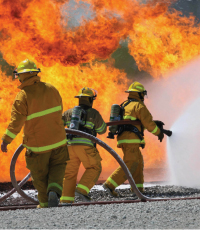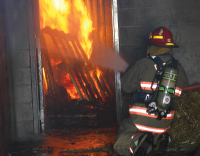
Top-notch training: State-of-the-art training institute opens doors to all departments
Laura King
Features Fire Ground TrainingWhen Air France flight 358 skidded off the runway at Pearson International Airport on Aug. 2, 2005, firefighters were on the scene in 52 seconds and got all 309 people aboard the Airbus A340 airliner safely out of the burning fuselage.
 |
| ABOVE: Firefighters from Athens International Airport train on the mock aircraft at FESTI. A remote-controlled propane fire simulates an airline fuel fire. BELOW: FESTI’s burn tower is constructed of exterior beams that allow for easy re-installation of deteriorating interior walls. PHOTOS BY JOHN RIDDELL
|
 |
When Air France flight 358 skidded off the runway at Pearson International Airport on Aug. 2, 2005, firefighters were on the scene in 52 seconds and got all 309 people aboard the Airbus A340 airliner safely out of the burning fuselage.
Firefighters with the Greater Toronto Airports Authority Fire Department saw flight 358 approaching in wet, rainy conditions, knew it was in trouble and sprung into action.
It’s a statistic the GTAA’s Fire and Emergency Services Training Institute, or FESTI, boasts about – and it should. As it happened, the Air France airliner landed on the runway closest to one of the GTAA Fire Department’s two stations (one north, one south). Regulations require a three-minute response time to the halfway point of the furthest runway from each station. The GTAA’s response is one to two minutes, among the best response times in Canada.
“I believe they were prepared [for the Air France disaster] because of this institute,” Deputy Chief Dwayne MacIntosh told reporters on a media day in May to celebrate the one-year anniversary of the revamped institute.
“I think we definitely played a part. We’re pretty proud of the fact that they did a phenomenal job that day.”
In 2005, the GTAA’s training facility comprised a control tower and a couple of training fuselages – and it still managed to provide a remarkable response to the Air France crash.
It also comprised some motivated officers who pushed hard for funding for a $15 million state-of-the-art institute, drew up a plan to turn the training centre into a thriving business. FESTI is adjacent to Pearson, sits on 45 acres of land (including the nearby hazmat training ground) and after a little more than a year in the new facility is becoming an internationally renowned training centre for airport, municipal and industrial fire departments. It also trains civilians in fire extinguisher use and shows off its premises to fire-service associations and school groups.
“We’re open to everybody, not just airport fire departments – that’s one of the biggest misconceptions,” says MacIntosh, a Nova Scotian and former military firefighter. (Several of FESTI’s officers are Nova Scotian – from Halifax, Donkin and Antigonish – and most are former military firefighters.)
FESTI has trained international firefighting teams from Belgium and Bermuda, and has just rolled out a marketing campaign aimed at Canadian departments along with those in the northern United States and Europe.
Teams from the Kelowna and Victoria, B.C., and Hamilton and Windsor, Ont., Toronto City Centre, Ottawa International and Prince Rupert airports have trained at FESTI. Industrial departments from Albion Sands and Fort McMurray have also used the facility.
In mid-May, a team of 14 firefighters from Athens International Airport spent four days training at FESTI. As MacIntosh pointed out, training crews get the royal treatment from FESTI, including hotel bookings, catered lunches and, in the case of the Athens group, an arranged trip to Niagara Falls.
Interestingly, the Greek firefighters were primarily municipal firefighters who were being relocated to an airport fire department and had little training in airport response.
Over and over, FESTI’s training offers put the Athens firefighters through response drills (the Athens chief was in command), igniting a ring of propane around a model fuselage and forcing the firefighters to improve their response. Placement of the mammoth airport fire trucks – which each hold 12,000 litres of water, 1,400 litres of foam and 500 pounds of dry chemicals – proper application, postioning, communication and other details were reviewed in post mortems and then tried again.
During training, the mock ups on the training ground burn about 24 times a day, four days a week for six to eight months before they’re closed down for the winter. The mock ups cannot operate in the freezing temperatures.
Since it opened last year, the new FESTI centre has trained more than 2,000 Firefighters, industrial and business personnel in structural fire fighting, aircraft fire fighting, confined space rescue, rope rescue, hazmat response and vehicle extrication.
Its courses – all available at www.gtaa.com/festi – range from $125 for a six-hour NFPF 472 hazardous materials awareness program to $15,000 for an 18-week NFPA 1001 level I and II firefighter / NFPA 1003 airport firefighter training program that covers everything from forcible entry to incident command.
FESTI also leases classroom space in its environmentally friendly classrooms (ergonomic chairs, state-of-the-art air-circulation system) to colleges and fire departments and will sends its instructors out to departments for training. FESTI’s hazmat crew worked on site with the Hamilton Fire Department in Ontario for the month of May.
FESTI will also customize training programs for departments and create new programs to meet departmental needs. It will offer an NFPA 1006 rope rescue technician course for the first time at the end of the summer.
Everything about FESTI was impeccably thought out and planned by architects and senior officers of the GTAA Fire and Emergency Services. Take the burn tower, for example. Generally, burn towers deteriorate over the years and have to be replaced or reconstructed. At FESTI, poured concrete pillars on the outside of the burn tower comprise the structural integrity of the tower. When interior walls begin to deteriorate, they can quickly and easily be replaced without compromising the structural integrity of the tower. This system also allows officers to change the interior layout of the tower without starting from scratch. MacIntosh found the concept for the tower on a Virginia-based website then worked the design into the layout he wanted for FESTI.
“We want to be able to train people to think outside the box,” he says, vastly understating the scope of FESTI’s amenities, programs and the calibre of its training officers.
The five-storey rescue tower features a photo luminescent safety way guidance system on stair railings and along the floor to primarily guide occupants out of a structure. MacIntosh will be doing trials with the manufacturer, Luminol, and the National Research council to determine if this type of system will benefit firefighters entering the structure for firefighting purposes and is convinced use of the material will become law in Canada before long. Similar photo luminescent material was being tested on the bottom three floors of one of the New York’s twin towers when the 9-11 terrorist attack happened.
The two aircraft models for airport training serve different purposes. The larger of the two has 10 exterior burn zones, controlled from the original tower on the FESTI site. Training officers can light one zone or 10 to produce up to 5,000 square feet of fire around the aircraft, to mimic burning fuel.
The smaller model is used to train for engine fires, wheel fires, and interior fire fighting and rescue.
The training area is designed with environmental sustainability in mind. Pits in the training field collect runoff from the training fires and if there are any contaminants in the water they are isolated and collected for disposal.
Toronto District Chief and Fire Fighting in Canada columnist Peter Sells calls FESTI “as close as an example of the perfect fire-training centre as I have seen in my 17 years in fire service training.”
FACTS ABOUT FESTI Offers:
Rescue tower Burn building Auto extrication area Hazardous materials training site |
Print this page